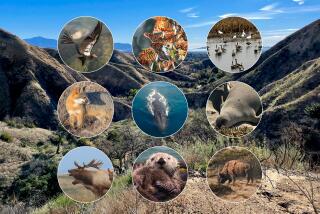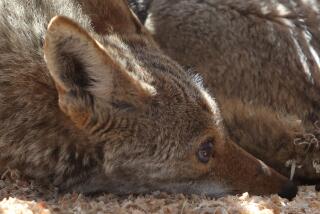A Few Wing Tips : Best Way to Locate Doves Is to Scout Seeded Areas Before the Season Opens
Rich Colby, a state game warden based in Blythe, was telling the story of a group of dove hunters who should have known better.
“Last year on opening day, there was a sesame seed field on 28th Street in Blythe that was just loaded with birds,” he said. “When I went by there very early in the morning, everyone I talked to had a limit.
“This year, I went by the same field very early in the morning, and there was just one group of hunters, standing around looking at a field of cantaloupes. They should have scouted the area--particularly this year, since opening day (Sept. 1) was a Sunday.
“Agricultural crops in the Palo Verde Valley and a lot of other good dove areas change from year to year, and hunters should allow for scouting time on their hunting trips. What was a good seed field one year might have been converted to something that won’t attract doves the next.”
The men standing in the cantaloupe field notwithstanding, the dove season’s opening day was a productive one for many hunters. Moreover, the shooting has remained productive as California’s first half of a split dove season enters its second week.
Another warden, Rusty McBride, who is based in Winterhaven, said some hunters are still bagging limits of mourning doves in the Winterhaven area, across the Colorado River from Yuma, Ariz. The Quechan Indian Reservation is particularly productive now, McBride added.
“You can get a reservation hunting permit for $15 at the Quechan Fish and Game office in Winterhaven,” he said. “I’ve seen a lot of birds in those fields, and not a lot of hunters around to scare ‘em and get them moving. I saw three limits last weekend and maybe a half-dozen hunters.”
The first part of California’s dove season will continue through Oct. 15. The second part will open Nov. 16 and close Nov. 30.
The usual script for the dove season in Southern California calls for numerous limits at traditionally productive hunting areas in the Imperial and Palo Verde valleys. Then, desert thunderstorms in early September chase the birds into Arizona or Mexico. This year, however, there have been only scattered, light rainstorms, and some good shooting still remains.
The script also usually calls for numerous citations for hunters exceeding limits, and 1985 is running true to form. The daily limit in California is 15 birds, of which only 10 can be white-winged doves.
McBride said: “The first two days of the season around Winterhaven were great. I saw a lot of limits, a lot of white-winged doves and a lot of over-limits. I cited 17 hunters for over-limits the first two days.”
Fair to good shooting continues in several areas near the Salton Sea, according to Jerry Netzley of Poor Richard’s, Inc., a sporting goods store at North Shore, near the Salton Sea.
“We haven’t had the big thunder-buster yet, so some birds will stick around until we do,” he said. “The opening day around here was very good. It hasn’t been that good since then, but it’s been consistent. There are still a lot of birds along the All-American Canal, all the other canals and in the Thermal area.”
Netzley offers a tip for next year’s opening-day hunters in the Imperial Valley:
“We noticed that a lot of guys with limits, who experienced really good shooting, were working barley fields that were located between grape vineyards.”
One of the dove season’s central characters is on the disabled list.
Jack Page of Palo Verde, veteran desert outdoorsman and a founder of the Palo Verde Rod and Gun Club, is in Veteran’s Hospital, Long Beach, with emphysema.
A skilled desert hunter of deer, waterfowl, dove, quail and jackrabbits--he is famous in Colorado River circles for his jackrabbit chili recipe--Page normally is something of a ringmaster on dove-season opening days in the Palo Verde area.
He has helped hundreds of hunters find productive shooting areas, on both private and public shooting lands. He has also been a leader in numerous wildlife conservation projects in the Colorado Desert, including the construction of wildlife water guzzlers.
More to Read
Sign up for The Wild
We’ll help you find the best places to hike, bike and run, as well as the perfect silent spots for meditation and yoga.
You may occasionally receive promotional content from the Los Angeles Times.






